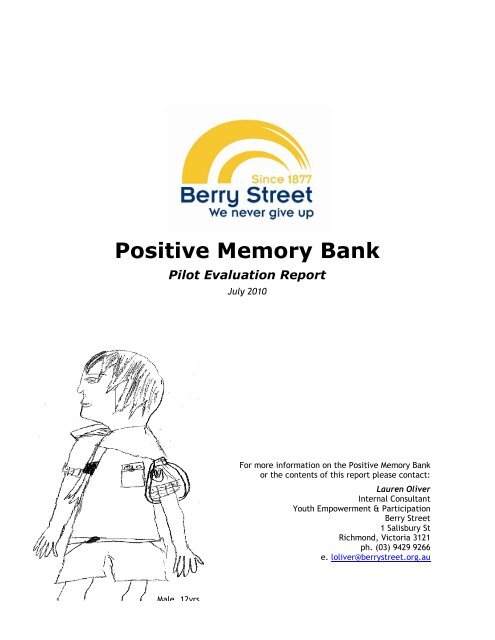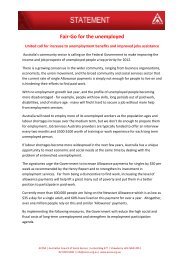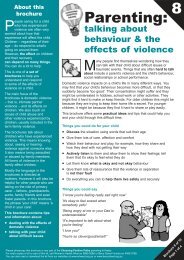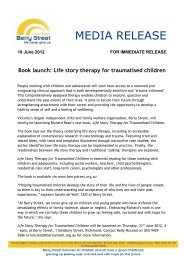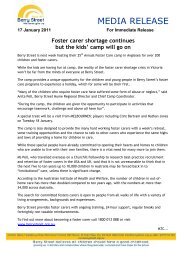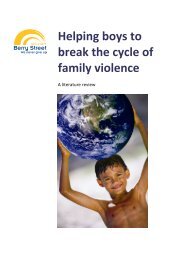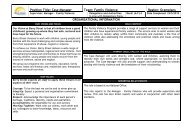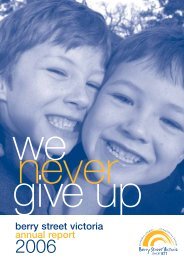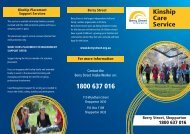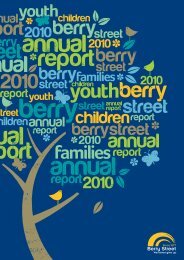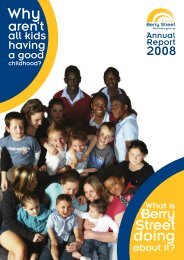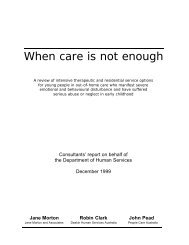Positive Memory Bank - Berry Street
Positive Memory Bank - Berry Street
Positive Memory Bank - Berry Street
You also want an ePaper? Increase the reach of your titles
YUMPU automatically turns print PDFs into web optimized ePapers that Google loves.
<strong>Positive</strong> <strong>Memory</strong> <strong>Bank</strong><br />
Pilot Evaluation Report<br />
July 2010<br />
For more information on the <strong>Positive</strong> <strong>Memory</strong> <strong>Bank</strong><br />
or the contents of this report please contact:<br />
Lauren Oliver<br />
Internal Consultant<br />
Youth Empowerment & Participation<br />
<strong>Berry</strong> <strong>Street</strong><br />
1 Salisbury St<br />
Richmond, Victoria 3121<br />
ph. (03) 9429 9266<br />
e. loliver@berrystreet.org.au<br />
[Type text]<br />
Male, 12yrs
Acknowledgements<br />
This evaluation was undertaken by the Youth Empowerment & Participation Project, part of the<br />
Statewide Services Team at <strong>Berry</strong> <strong>Street</strong>.<br />
A number of people provided feedback, stories and input through the evaluation process and we<br />
are grateful to them for their honest and constructive contributions. We are particularly grateful<br />
to the young people who shared their experiences with us and who have allowed us to use their<br />
drawings, letters and information throughout this report.<br />
In particular <strong>Berry</strong> <strong>Street</strong> would like to acknowledge the work undertaken by Elissa Livesey<br />
during her student placement with <strong>Berry</strong> <strong>Street</strong>. Much of the data and information from staff,<br />
children and young people is drawn from her work in surveying and interviewing successful<br />
<strong>Positive</strong> <strong>Memory</strong> <strong>Bank</strong> applicants.<br />
<strong>Berry</strong> <strong>Street</strong> would also like to thank the generous contributions of the Newsboys Foundation and<br />
the Hoffman Foundation, which made this pilot project possible.<br />
Page | 1
Contents<br />
Acknowledgements …………………………………………..……………………………… 1<br />
Executive Summary …………………………………………………………………………. 3<br />
Recommendations …………..………………………………………………………………. 7<br />
1. Introduction …………………………………………………………………………….. 10<br />
1.1 Methodology ………………………………………………………………………………………………. 11<br />
2. Outcomes …………………………………………………………………………………. 12<br />
2.1 Opportunities Facilitated ……………………………………………………………………………. 12<br />
2.2 Grant Recipients …………………………………………………………………………………………. 12<br />
2.3 Support Staff ………………………………………………………………………………………………. 13<br />
2.4 <strong>Berry</strong> <strong>Street</strong> Culture …………………………………………………………………………………… 14<br />
3. Quantative data ………………………………………………………………………… 15<br />
3.1 General ……………………………………………………………………………………………………….. 15<br />
3.2 Giving Round One ………………………………………………………………………………………. 16<br />
3.3 Giving Round Two ………………………………………………………………………………………. 16<br />
3.4 Giving Round Three ……………………………………………………………………………………. 16<br />
4. Application process …………………………………………………………………… 17<br />
4.1 From the Applicants …………………………………………………………………………………… 17<br />
4.2 From the Support Workers ………………………………………………………………………… 17<br />
4.3 Application Receipt and Processing …………………………………………………………… 18<br />
5. Giving rounds ……………………………………………………………………………. 19<br />
5.1 Giving Group ………………………………………………………………………………………………. 19<br />
6. Grant-making and tracking …………………………………………………………. 21<br />
7. Conclusions ………………………………………………………………………………. 22<br />
8. Appendices ……………………………………………………………………………….. 23<br />
App. 1: Grants List ……………………………………………………………………………………………. 23<br />
App. 2: Case Study - Mary ……………………………………………………………………………….. 25<br />
App. 3: Case Study # 2 …………………………………………………………………………………….. 26<br />
App. 4: Case Study # 3 …………………………………………………………………………………….. 27<br />
App. 5: Application Form …………………………………………………………………………………… 28<br />
App. 6: Application Guidelines …………………………………………………………………………… 35<br />
App. 7: Application Assessment Form ………………………………………………………………. 37<br />
Page | 2
Executive Summary<br />
“I’ve dreamed of my 18th Birthday Party. It was on a boat and I had all the people that have made a<br />
difference in my life. I have never had a real party so I thought I would take this opportunity to tell you my<br />
dream so it might come true”<br />
Female, 17yrs.<br />
<strong>Berry</strong> <strong>Street</strong> believes that all children should have a good childhood. We also understand that, if<br />
memories provide us with a context for who we are, positive memories can be understood to<br />
play a significant role in building resilience in children and young people. They offer us a<br />
positive image of ourselves, the people around us and the things we are capable of.<br />
The <strong>Positive</strong> <strong>Memory</strong> <strong>Bank</strong> (PMB) was developed in response to a perceived need for an<br />
independent source of funds to enable <strong>Berry</strong> <strong>Street</strong> to provide children and young people with<br />
opportunities to build their own bank of positive memories.<br />
“Some of the school parents and students are aware of the family’s current child protection involvement,<br />
which has exacerbated [their] social isolation resulting in the children having few friendships and being<br />
excluded from student’s parties due to parents telling their children not to play with [them]…”<br />
Family Services worker<br />
For many of the children and young people in our programs and services, <strong>Berry</strong> <strong>Street</strong> acts in<br />
loco parentis and, as such, is responsible for ensuring that they are provided with the<br />
experiences, the resources, the relationships and the opportunities to be the best they can be.<br />
For others our role is to engage and support them in a variety of ways to overcome barriers, to<br />
feel safe and nurtured and to have hope for the future.<br />
The pilot of the PMB aimed to test a model of small-grant-making to individual children and<br />
young people in all <strong>Berry</strong> <strong>Street</strong> programs and services. The intention was to ensure that<br />
children and young people were empowered by the process, supported by <strong>Berry</strong> <strong>Street</strong> staff, and<br />
ultimately enabled to access opportunities and resources they may otherwise have struggled to<br />
access.<br />
The development of the model was supported by a reference group including direct service staff<br />
from a range of <strong>Berry</strong> <strong>Street</strong> program areas as well as staff from <strong>Berry</strong> <strong>Street</strong>’s central office. In<br />
addition the reference group included the CEO of the Newsboys Foundation.<br />
The Reference Group developed the concept to include a definition of positive memories, an<br />
application process and application guidelines. This was subsequently launched, with the pilot<br />
year offering three funding rounds to distribute a total of $41,000. Applications were invited<br />
from all program and service areas of <strong>Berry</strong> <strong>Street</strong> for activities and opportunities that:<br />
• Promote fun – opportunities to play, have adventures, be a child etc.<br />
• Provide ‘normal’ experiences – opportunities to do things that other kids their age do,<br />
things that connect them to their peers and community outside the welfare system, going<br />
to restaurants, camping, having sleepovers etc.<br />
• Enable a sense of achievement – Things that enable them to feel like they have<br />
something to offer, skills that people value, the ability to succeed.<br />
• Connect children and young people to their family – opportunities that facilitate and<br />
support connection to family like enabling a family member to attend their Deb Ball, or<br />
supplying a family movie pass or zoo pass so they can do activities together.<br />
• Provide resources – equipment and financial resources that enable them to access<br />
recreation and personal development opportunities such as musical instruments or the<br />
money to pay for music lessons.<br />
The key requirement in the application process was that, where possible, children and young<br />
people had to be the ‘driver’ behind the application. The guidelines encouraged staff to<br />
Page | 3
empower their clients to decide what constitutes a positive memory experience for them and to<br />
undertake the research to make their application. Application forms were developed to be as<br />
‘child/youth-friendly’ as possible, requiring minimal written information and encouraging<br />
submissions in any format the child or young person wanted to use. This resulted in applications<br />
including drawings, photographs, voice-recordings, DVDs, , personal presentations from children<br />
and even a wooden sculpture.<br />
To ensure that requests were clear, all applications had to be supported by a detailed letter<br />
from a <strong>Berry</strong> <strong>Street</strong> staff member, outlining the request 1 , their reasons for supporting the<br />
application and any further information that might help in decision-making.<br />
“getting a driver’s licence or supervised driving is hard, because most newly-arrived people are still on P-P<br />
plates. It has happened that other p-platers platers have been known to supervise learner drivers and other people<br />
have driven without licences. I believe [he] needs an opportunity to do things the proper way”<br />
Cultural Liaison worker<br />
Over the twelve month pilot, which ran from May 2009 – May 2010, with grant rounds taking<br />
place in May 2009, September 2009 and November 2009, the full $41,000 was granted. Over 70<br />
applications were received across the three rounds totalling nearly $67,000 in requests.<br />
Applications contained requests for a huge range of opportunities, activities and resources, many<br />
of which provided a stark reminder of the array of socially accepted ‘norms’ of childhood that<br />
vulnerable and disadvantaged children and young people are prevented from experiencing<br />
through circumstances over which they have no control.<br />
Examples of applications include:<br />
• Piano lessons for a young girl transitioning into permanent care:<br />
“Playing the piano makes me feel happy and forget about the sadness…”<br />
1 Where applicants were too young or unable to provide any written details of the activity or opportunity they wanted<br />
to take part in, the support letter was used to provide the detail of the application.<br />
Page | 4
• Horse-riding lessons for a girl with behavioural and developmental disorders:<br />
“My client’s greatest desire is to ride horses, she has a love for horses and has started writing a<br />
dictionary on horses… unfortunately we do not have the finances to place her in a day program for<br />
horse riding lessons”<br />
• A group application from young people from a regional education program for an outing<br />
to an inner-city Skate Park<br />
“We would like to go on a trip to Rampfest, Melbourne… everyone here enjoys the sk8 park here in<br />
Shepparton, but it is a bit small and does not let us practice all of the tricks some of us can do<br />
because it doesn’t have half-pipes and stuff”<br />
• Holidays: Queensland Adventure Parks, beachside family holidays<br />
• Academic support: tutoring<br />
• Family activities: long-distance travel to visit family, zoo trips, decorating bedrooms<br />
• Leisure equipment: bikes, scooters, fishing equipment<br />
• Group activities: Luna Park, Melbourne skate park<br />
• Dance lessons<br />
• Theatre experiences<br />
• Driving lessons<br />
• Birthday parties<br />
“I want to be able to read and write just as good as other kids in my class… I wish that I could get stars every<br />
day at school. School work is too hard for me. I want to be happy at school”<br />
Female, 6yrs<br />
Applications were assessed initially by the project manager and subsequently by a ‘Giving Group’<br />
made up of staff from a range of program and service areas across the organisation. The original<br />
intention was to include young people in the Giving Group. This was achieved in the first group,<br />
however it became impossible to coordinate an appropriate time to accommodate staff and<br />
young people during work and school hours.<br />
Each round saw the pool of applications grow. The second round received double the number of<br />
the first, and the third round saw a leap from sixteen applications (in the second round) to 47.<br />
As word spread we also saw the diversity of program areas grow. The initial round was largely<br />
made up of applications from <strong>Berry</strong> <strong>Street</strong>’s North West Region Home Based Care and Family<br />
Services programs. By the final round applications were received from all regions, including Take<br />
Two 2 and the Bushfire Case Management Services.<br />
The unexpected and rapid increase in application numbers came at a time when administrative<br />
support within <strong>Berry</strong> <strong>Street</strong>’s Richmond Office (where the program is based) was stretched.<br />
Where applications had been received and processed for assessment by a member of the<br />
administration team, before being submitted to the Project Manager for review, the reduced<br />
capacity in administration meant that the Project Manager was responsible for receiving and<br />
processing all 47 applications in the final round. These factors resulted in the model being<br />
tested ‘under strain’, which was arguably both positive and negative. On the one hand it<br />
enabled thorough testing of the integrity of the application process, the guidelines and the<br />
concept behind the <strong>Positive</strong> <strong>Memory</strong> <strong>Bank</strong>. On the other hand it resulted in unprecedented<br />
numbers of unsuccessful applications in the final round. In previous rounds the Giving Group had<br />
been able to fund applications to their full amount and in some cases provide additional funds to<br />
ensure the experiences were especially memorable. Conversely, in the final round, with over<br />
$45,000 of applications and only $19,000 left to spend, the guidelines had to be strictly adhered<br />
to. A decision was made to exclude some categories of application altogether 3 , and applications<br />
were assessed for their potential to achieve the same result with a little less money. This<br />
2 A developmental therapeutic service for clients of the Victorian Child Protection system.<br />
3 Applications for computers and laptops were referred to the Development Team to pursue with corporate and<br />
independent supporters.<br />
Page | 5
inevitably resulted in negative feedback and disappointment for many children and young people<br />
as well as for the staff who had supported them.<br />
“Although my client has accepted the decision and moved on, I am personally disappointed”<br />
Bushfire Case Manager<br />
Despite the handful of negative experiences, the feedback regarding the <strong>Positive</strong> <strong>Memory</strong> <strong>Bank</strong><br />
has been overwhelmingly positive. Some have indicated that, without access to the <strong>Positive</strong><br />
<strong>Memory</strong> <strong>Bank</strong>, , many of these activities would not have taken place since there are limited<br />
sources for funding for the extra things that make childhood fun and special. We have also heard<br />
that the existence of the PMB has, in some cases, influenced a change in the way that staff<br />
approach their work with children and young people; it has provided them with a very positive<br />
lens through which to view their clients, as well as a positive tool for engaging them more<br />
generally.<br />
Most importantly we have heard heart-felt requests, overjoyed squeals of excitement and<br />
messages of fun and adventure from children and young people in their applications, through<br />
their feedback and during their visits to Richmond office to personally hand in their application<br />
forms. Their responses confirm for us the importance of initiatives that focus on the positive, on<br />
their strengths and on their right to have the same opportunities and chances in life that are<br />
routinely available to their peers.<br />
“I would give it 20 out of 10 it was so fun!”<br />
Male, 12yrs<br />
Male, 11yrs<br />
Page | 6
Recommendations<br />
“[PMB] is an excellent project, just a shame it has to be capped to only a couple of times a year. As from<br />
time to time opportunities rise (sic) and it creates problems getting money for the activity or opportunity for<br />
the [young people] and they often miss out”<br />
Staff member<br />
The following recommendations are drawn from the range of feedback that was received both<br />
during the application processes and through targeted surveys following the end of the pilot.<br />
These recommendations assume that the continuation of the <strong>Positive</strong> <strong>Memory</strong> <strong>Bank</strong> is not in<br />
question. Some funding has been secured to continue the program and <strong>Berry</strong> <strong>Street</strong> has<br />
articulated a commitment to the continued building of a perpetual fund to create a sustainable<br />
funding source for the PMB.<br />
The recommendations below provide guidance for ongoing development of the PMB with the<br />
intention to improve the process and outcomes, ultimately ensuring that the experience as a<br />
whole is positive for all involved.<br />
1. Develop the Giving Group process to engage young people in a meaningful way.<br />
1a. Consult with young people to ascertain the best methods for facilitating youth<br />
participation in the model<br />
1b. Explore the feasibility of conducting all, or part of Giving Group sessions, through<br />
<strong>Berry</strong> <strong>Street</strong> education programs or in Residential Units<br />
1c. Schedule Giving Group meetings for school holidays<br />
1d. Address the issues of applicant confidentiality when involving other young people in<br />
the Giving Group process.<br />
2. Ensure clarity and transparency in the applications process to enable applicants to<br />
better manage their expectations and cope with the outcomes<br />
2a. Provide case studies and examples of successful applications to offer applicants<br />
inspiration and an understanding of what the PMB funds.<br />
2b. Recruit representatives to the Giving Group from every region/group and spend an<br />
initial session training them to facilitate information sessions in their region/group<br />
regarding the <strong>Positive</strong> <strong>Memory</strong> <strong>Bank</strong>.<br />
2c. Place greater emphasis on the need to prepare applicants for the possibility that<br />
their application may NOT be successful.<br />
2d. Simplify the information available to applicants and support workers<br />
2e. Review and update application forms to further promote alternatives to written<br />
applications.<br />
3. Streamline the process for receiving, processing and the long-term ownership and<br />
storage of applications.<br />
3a. Establish administrative support by assigning the <strong>Positive</strong> <strong>Memory</strong> <strong>Bank</strong> as the<br />
permanent portfolio of a member of the Central Administration team<br />
3b. Assign Unique Identifiers to each applicant to monitor multiple applications over<br />
Giving rounds and ensure there is a tracking mechanism in place<br />
3c. Establish a system for the storage and return of applications to applicants following a<br />
defined period so as to ensure consistency with life story work, etc. Include this in<br />
the guidelines for workers<br />
Page | 7
4. Improve the model for monitoring expenditure through the <strong>Positive</strong> <strong>Memory</strong> <strong>Bank</strong><br />
4a. Provide successful applicant’s support workers with the application Reference<br />
Number to tag their payments for tracking<br />
4b. Require support workers to notify admin support when they have used the funds<br />
4c. Meet with finance and Development to ensure financial and donation management<br />
processes are clear and documented<br />
5. Plan and publicise frequency of Giving rounds and availability of funds to avoid overspending<br />
in early rounds and ensure equity of opportunity in each round<br />
5a. Following confirmation of the funds available for the year, set funding-round dates<br />
and announce the amount of funding that will be available at each round<br />
5b. Encourage year-round submission of applications to avoid the ‘last-minute-rush’<br />
approach<br />
Page | 8
Male, 11yrs Page | 9
1. Introduction<br />
<strong>Berry</strong> <strong>Street</strong> believes all children should<br />
have a good childhood, growing up feeling<br />
safe, nurtured and with hope for the<br />
future.<br />
In 2007 <strong>Berry</strong> <strong>Street</strong> received applications<br />
totalling over $20,000 for a scholarship fund<br />
that held only $4,000. All the requests were<br />
for what might be considered ‘normal’<br />
childhood opportunities or resources: art<br />
equipment to be able to paint and draw,<br />
music lessons, a skateboard. Even a request<br />
from two sisters for funds to support an<br />
overseas trip was not out of the ordinary for<br />
young women of their age, ready to explore<br />
the world. In many situations a parent might<br />
do their best to support, or endeavour to<br />
provide these opportunities for growth and<br />
development in their child. For families that<br />
are struggling or facing challenges such as<br />
domestic violence, mental illness, substance<br />
abuse, financial hardship or separation, the<br />
provision of what may be regarded as ‘nonessential’<br />
experiences are often out of reach<br />
or too far down the list of priorities to<br />
consider.<br />
<strong>Berry</strong> <strong>Street</strong> has an in loco parentis role for<br />
the children and young people in programs<br />
and services as part of Out of Home Care<br />
provision. Further, the organisation plays a<br />
supportive role for many Victorian families<br />
facing challenges and tough times. <strong>Berry</strong><br />
<strong>Street</strong> believes that this commitment to<br />
supporting children, youth and families<br />
includes finding ways to ensure that children<br />
and young people continue to have access to<br />
the rites of passage, opportunities for pure<br />
fun and positive growth experiences<br />
commonly available to their peers. Further,<br />
<strong>Berry</strong> <strong>Street</strong> is committed to ensuring that<br />
they are able to connect to their<br />
communities, peers and families and to<br />
develop resilience through positive<br />
memories.<br />
This commitment, combined with the ever<br />
present pressure to fundraise to sustain a<br />
handful of programs focusing on providing<br />
children and young people with positive and<br />
fun opportunities, inspired the development<br />
of the <strong>Positive</strong> <strong>Memory</strong> <strong>Bank</strong>.<br />
The <strong>Positive</strong> <strong>Memory</strong> <strong>Bank</strong> (PMB) was<br />
developed to:<br />
1. Empower children & young people to<br />
participate in decisions affecting<br />
them;<br />
2. Enable children and young people in<br />
<strong>Berry</strong> <strong>Street</strong> programs and services to<br />
access opportunities, rites of passage<br />
and positive experiences that<br />
contribute to their own bank of<br />
positive memories; and<br />
3. Provide <strong>Berry</strong> <strong>Street</strong> staff and young<br />
people with the opportunity to<br />
participate in the distribution of funds<br />
to support themselves and their peers<br />
by;<br />
4. Create a sustainable funding source<br />
for projects, materials and activities<br />
which enhance our capacity to build on<br />
positive memories for children and<br />
young people in our care.<br />
Generous seed funding through the<br />
Newsboys Foundation and the Hoffman<br />
Foundation, made the development of the<br />
concept into a reality, and a pilot year<br />
possible.<br />
In the first three months a Reference Group<br />
was established to guide the development of<br />
the <strong>Positive</strong> <strong>Memory</strong> <strong>Bank</strong> concept,<br />
including: a definition of positive memory<br />
activities and opportunities; a clear<br />
application process; and application and<br />
publicity materials<br />
In addition to the project manager 4 , the<br />
Reference Group included three nominated<br />
representatives from <strong>Berry</strong> <strong>Street</strong> programs<br />
(Family Services, Residential Case<br />
Management and Intensive Case Management<br />
Service), representatives from <strong>Berry</strong> <strong>Street</strong><br />
Business Operations and Development<br />
Teams, and Sandy Shaw, CEO of the<br />
Newsboys Foundation.<br />
Grant assessment was carried out by a<br />
Giving Group. This group included four<br />
permanent members with the capacity to<br />
invite others to participate, where<br />
appropriate. In the interests of youth<br />
participation it was also intended that this<br />
4<br />
Lauren Oliver, Internal Consultant: Youth<br />
Empowerment & Participation<br />
Page | 10
group should include a minimum of two<br />
young people for each Giving Round.<br />
Three Giving Rounds took place over the<br />
pilot year, in May, September and November<br />
of 2009. A fourth had been anticipated, but<br />
demand was so high in the first three, that<br />
funds were unavailable by the end of the<br />
third Giving Round.<br />
1.1 Methodology<br />
This evaluation has been conducted<br />
internally by <strong>Berry</strong> <strong>Street</strong> under the<br />
assumption that the future viability of the<br />
<strong>Positive</strong> <strong>Memory</strong> <strong>Bank</strong> is not in question.<br />
There has already been a substantial<br />
financial investment made to an endowment<br />
fund to ensure the longevity of the program.<br />
In addition the <strong>Positive</strong> <strong>Memory</strong> <strong>Bank</strong> has<br />
been made the subject of a Major Donor<br />
campaign and the default recipient of a<br />
large number of donations and bequests as<br />
well as the <strong>Berry</strong> <strong>Street</strong> employee giving<br />
program. The long-term vision is to build a<br />
large enough fund to enable the <strong>Positive</strong><br />
<strong>Memory</strong> <strong>Bank</strong> to continue to fund individuals<br />
and, in the future, to sustain some of <strong>Berry</strong><br />
<strong>Street</strong>’s positive memory focused programs<br />
such as the Foster Care Camp, Darwin<br />
Experience and Wilderness Project.<br />
The objective of the evaluation process was<br />
to identify areas for improvement from the<br />
perspectives of all involved. A random and<br />
representative group of 20 successful<br />
applicants was selected to provide<br />
feedback. Surveys were then sent to the<br />
<strong>Berry</strong> <strong>Street</strong> worker who supported their<br />
application and to the applicant themselves.<br />
In some cases applicants were interviewed<br />
by a student from RMIT to complete the<br />
survey.<br />
Second and third round applicants also<br />
completed evaluation surveys with their<br />
applications to provide feedback on the<br />
process itself.<br />
Additional feedback was received from<br />
successful and unsuccessful applicants<br />
throughout the pilot via email and through<br />
phone conversations. This feedback has also<br />
been incorporated.<br />
Page | 11
2. Outcomes<br />
Three full case studies are attached with<br />
this report as Appendices 2-4.<br />
In addition to the specific nature of the<br />
opportunities facilitated through the<br />
<strong>Positive</strong> <strong>Memory</strong> <strong>Bank</strong>, over $40,000 in<br />
grants were committed to more than 50<br />
children and young people. However, the<br />
outcomes of the pilot project have reached<br />
far beyond the financial, both among those<br />
who received the grants and among staff. To<br />
some extent there has also been an impact<br />
on aspects of <strong>Berry</strong> <strong>Street</strong> culture.<br />
2.1 Opportunities Facilitated<br />
For a full list of opportunities facilitated by<br />
the <strong>Positive</strong> <strong>Memory</strong> <strong>Bank</strong>, see Appendix 1.<br />
The following provide a snapshot of some of<br />
the things <strong>Positive</strong> <strong>Memory</strong> <strong>Bank</strong> funds<br />
enabled:<br />
A group application from young people<br />
from a regional education program for an<br />
outing to an inner-city Skate Park<br />
“We would like to go on a trip to Rampfest,<br />
Melbourne… everyone here enjoys the sk8<br />
park here in Shepparton, but it is a bit<br />
small and does not let t us practice all of the<br />
tricks some of us can do because it doesn’t<br />
have half-pipes and stuff”<br />
“School work is too hard for me. I want to<br />
be happy at school”<br />
Part of the costs to enable a fifteen year<br />
old boy with an identified talent for soccer<br />
to travel with his team to a Football Camp<br />
and international tournament in Singapore<br />
Funds to enable a little boy in foster care<br />
to visit his paternal grandmother on a<br />
regular basis and build on the newlyformed<br />
relationship they have developed<br />
A suit and new shoes for a homeless young<br />
man to attend his brother’s wedding<br />
A new bike and helmet for a little girl in<br />
foster care to replace the one that she has<br />
grown out of<br />
Birthday parties for several young people<br />
including a sweet sixteen, an eighteenth<br />
and a birthday party for a young woman<br />
entering a permanent care placement and<br />
wanting to farewell her friends and<br />
support workers before she leaves<br />
“I’ve dreamed of my 18th Birthday Party. It<br />
was on a boat and I had all the people that<br />
have made a difference in my life. I have<br />
never had a real party so I thought I would<br />
take this opportunity to tell you my dream<br />
so it might come true”<br />
Specialised tutoring for two young sisters<br />
with severe learning delays<br />
“I want to be able to read and write just as<br />
good as other kids in my class… I wish that I<br />
could get stars every day at school”<br />
2.2 Grant Recipients<br />
When asked about the impact of the<br />
application process and their use of the<br />
grant, children and young people told us it<br />
had been a very positive experience. For<br />
some it enabled them to feel ‘normal’ and<br />
more like their peers or children and young<br />
people they are at school with. They told us<br />
it was empowering because they gained<br />
skills and accessed opportunities that might<br />
Page | 12
not have been available to them, were it not<br />
for the money they received from the<br />
<strong>Positive</strong> <strong>Memory</strong> <strong>Bank</strong>.<br />
“Mary was overjoyed by the gifts. It is a rare day<br />
that she gets something just for herself”<br />
Case Study, Appendix 4<br />
Among other objectives, the <strong>Positive</strong><br />
<strong>Memory</strong> <strong>Bank</strong> hopes to provide opportunities<br />
for children and young people to have fun.<br />
Feedback, and the nature of the<br />
opportunities applicants accessed, implies<br />
that this was very much the case for the<br />
majority of those who received grants.<br />
Young people surveyed also told us that they<br />
achieved in ways that were special and new<br />
to them. For some the achievements were in<br />
areas they had always wanted to achieve,<br />
for others they were incidental or part of<br />
the experience as a whole.<br />
“I learnt First Aid and got to become a First Aid<br />
officer [at scout jamboree]”<br />
Male, 12 yrs<br />
Where some children and young people<br />
applied for funds to support a connection to<br />
their family, others considered their<br />
opportunity a chance to connect with their<br />
peers. It seemed important for some young<br />
people to find things to do together, such as<br />
reading books together or playing with toys<br />
and generally just having the chance to<br />
spend time with their birth family or foster<br />
family. When asked if the <strong>Positive</strong> <strong>Memory</strong><br />
<strong>Bank</strong> money helped young people connect<br />
more or better with their birth or foster<br />
family we heard back that for half of those<br />
surveyed, it did.<br />
For some of those surveyed, the <strong>Positive</strong><br />
<strong>Memory</strong> <strong>Bank</strong> was also about wanting to do<br />
something to further themselves as a person<br />
or learn a new skill through activities such as<br />
guitar lessons, violin lessons, driving lessons<br />
and tutoring.<br />
Given that surveys showed that the majority<br />
of children and young people heard about<br />
the <strong>Positive</strong> <strong>Memory</strong> <strong>Bank</strong> via word of mouth<br />
it was encouraging to find that they were<br />
enthusiastic when asked if they would<br />
encourage others to apply:<br />
“The <strong>Positive</strong> <strong>Memory</strong> <strong>Bank</strong> seems like a pretty<br />
good idea - Go for it”<br />
2.3 Support Staff<br />
Male, 14yrs<br />
We asked 20, randomly selected support<br />
staff about the impact of the <strong>Positive</strong><br />
<strong>Memory</strong> <strong>Bank</strong> against the five focus areas of<br />
the <strong>Positive</strong> <strong>Memory</strong> <strong>Bank</strong> (promoting fun,<br />
providing ‘normal’ experiences, enabling a<br />
sense of achievement, connecting children<br />
and young people to their family and<br />
providing resources);<br />
• 85% indicated that the grant enabled<br />
a sense of achievement<br />
• 75% felt the grants their clients<br />
received enabled fun, connection to<br />
family and a chance to be like their<br />
peers<br />
• 70% noted the grant had supported<br />
access to resources<br />
One hundred percent of support staff said<br />
they would encourage children and young<br />
people to apply for the <strong>Positive</strong> <strong>Memory</strong><br />
<strong>Bank</strong> again in the future.<br />
While the <strong>Positive</strong> <strong>Memory</strong> <strong>Bank</strong> had<br />
articulated aims in terms of the areas it<br />
hoped to impact, we also asked staff about<br />
any additional benefits they had seen as a<br />
result of the application process or the<br />
grants received.<br />
As the table below demonstrates children<br />
and young people benefited in a variety of<br />
ways, including improved self esteem,<br />
improved self-image, improved skills,<br />
connection to new friends and discovering<br />
new interests. Staff also indicated that they<br />
had experienced children and young people<br />
gaining a more positive outlook as well as<br />
overall improved health and wellbeing.<br />
Page | 13
2.4 <strong>Berry</strong> <strong>Street</strong> Culture<br />
Anecdotal evidence and input throughout<br />
the pilot has indicated that, for many<br />
people, the <strong>Positive</strong> <strong>Memory</strong> <strong>Bank</strong> has<br />
provided an opportunity to reflect on the<br />
needs of children and young people from a<br />
new and often refreshing perspective.<br />
In emails staff expressed their excitement<br />
and that of family members at being able to<br />
focus on the less serious side of life with<br />
their clients.<br />
“the kids sat down over the weekend and drew<br />
many pictures of things they love, memories they<br />
have and a wish. We actually had a few good<br />
hours together of lots of laughs and happy<br />
thoughts… Even if nothing comes of it it was a<br />
great exercise to do with them. Thanks”<br />
Mother of applicant – Bushfire Case Management<br />
Service<br />
At an Executive Management meeting<br />
following a presentation on the <strong>Positive</strong><br />
<strong>Memory</strong> <strong>Bank</strong>, the Executive Management<br />
Team discussed the impact that they were<br />
seeing among staff as a response to<br />
accessing the <strong>Positive</strong> <strong>Memory</strong> <strong>Bank</strong> for their<br />
clients.<br />
Specifically, one Regional Director felt that<br />
their staff had benefited from the<br />
opportunity to step back from the crisisfocused<br />
and often negative behavioural<br />
focus of their work with young people. The<br />
positive focus of the PMB had provided a<br />
different lens through which to view the<br />
young people in their care and a reminder<br />
that, as well as being children and young<br />
people with emotional and behavioural<br />
challenges, they, like any other child or<br />
young person, deserve to just have fun<br />
sometimes.<br />
“I am just over the moon for them as this is such a<br />
positive thing for them. These are the times that<br />
don’t happen often for our [young people]… What<br />
a memory it is in itself .This is a day that will be in<br />
their memory forever”<br />
Therapeutic Residential Unit Supervisor<br />
Page | 14
3. Quantitative Data<br />
3.1 General<br />
Applications were invited from individuals<br />
and from groups. The characteristics of the<br />
groups which applied were hard to track,<br />
because in many cases the group of young<br />
people who applied did not end up being the<br />
same as the group who then participated in<br />
the activity. This may have been the result<br />
of multiple factors including natural<br />
attrition in the time lapse between<br />
application and opportunity, or applications<br />
being developed on a program basis and the<br />
group within the program changing over<br />
time.<br />
Among the applications submitted<br />
by<br />
individuals 39 were from female applicants<br />
and 25 from male applicants.<br />
Applicants were invited to self-identify their<br />
cultural identity if it was anything other<br />
than Anglo-Australian. Australian. Between the first and<br />
third application rounds applications from<br />
non-Anglo-Australians Australians increased from 20% to<br />
28%. Applicants identifying as Indigenous<br />
stayed static in the first and second round,<br />
but doubled in the third round.<br />
The following list is drawn from both the<br />
individual and group applications and covers<br />
all three rounds. The figures represent the<br />
total number of young people in each<br />
cultural group<br />
across all three Giving<br />
Rounds.<br />
• Aboriginal/Indigenous/Koori – 8<br />
• Sudanese/Dinka - 3<br />
• Macedonian - 3<br />
• New Zealanders – 2<br />
• Lebanese, Australian-Italian, Italian,<br />
Greek, Syrian and Ethiopian – 1 each<br />
Applications came from all the <strong>Berry</strong> <strong>Street</strong><br />
practice Groups. The table below shows the<br />
number of applications received from each<br />
group, across all three application rounds<br />
and includes those withdrawn before or<br />
after the Giving Group met.<br />
Application by Group<br />
24<br />
21<br />
15<br />
6<br />
7<br />
Hume<br />
North West Southern Gippsland Take Two<br />
(Therpeutic)<br />
The first application round received ten<br />
applications. The second saw an increase of<br />
60% (total 16 applications) and the third saw<br />
an overall increase of almost 300% from the<br />
second round and 470% from the first (47<br />
applications in total).<br />
This volume of increase in applications was<br />
completely un-expected. . It was observed<br />
that more applicants and support workers<br />
were contacting the PMB project manager<br />
for advice before submission, but this<br />
communication alone did not indicate the<br />
sharp increase in application numbers.<br />
The impact was also seen in the quantity of<br />
funding available and requested. In the first<br />
round just over $9,000 was requested. The<br />
second saw requests totalling $14,500 and<br />
the third round, $43,000.<br />
Page | 15
The table below demonstrates the gap available for grant-making in each round.<br />
between the e requested funds and the funds<br />
50000<br />
45000<br />
40000<br />
35000<br />
30000<br />
25000<br />
Funds requested<br />
20000<br />
Funds available<br />
15000<br />
10000<br />
5000<br />
0<br />
1<br />
2 3<br />
3.2 Grant Round One<br />
The first grant round received ten<br />
applications, totalling $9,130 in requests. Of<br />
those ten, two were withdrawn before the<br />
Giving Group met, resulting in a total of<br />
$7,130 in requests going to the Giving<br />
Group. A further two applications were<br />
withdrawn following the Giving Group<br />
meeting.<br />
The total amount funded for the first round<br />
of the <strong>Positive</strong> <strong>Memory</strong> <strong>Bank</strong> was $6,039.<br />
The majority of applications came from the<br />
North West region Home Based Care and<br />
Family Services teams.<br />
3.3 Grant Round Two<br />
In the second round, with $35,000 still to<br />
spend, the PMB received 16 applications for<br />
a total of $14,584. One application was<br />
withdrawn before the Giving Group met and<br />
a total of $16,049 was granted.<br />
The gap between what was requested and<br />
what was granted is explained by the fact<br />
that several applications requested the<br />
maximum amount per application ($1,000),<br />
but t indicated that the opportunity would<br />
likely require further funding from<br />
elsewhere. In such cases the Giving Group<br />
opted to give the extra money in order to<br />
ensure that the opportunity could be fully<br />
enjoyed, knowing that funding from<br />
elsewhere would be hard to secure.<br />
In this second round the origins of the<br />
applications were more diverse, with some<br />
from every group, although not necessarily<br />
from every program area.<br />
3.4 Grant Round Three<br />
Forty-seven applications were received for<br />
the third round of grant-making. The total<br />
requested was $43,000. One application for<br />
$500 was processed ahead of the Giving<br />
Group meeting via a process of email<br />
consultation with Giving Group members.<br />
This was due to the date of the opportunity<br />
falling prior to the scheduled Giving Group<br />
meeting.<br />
Two applications were withdrawn prior to<br />
the Giving Group meeting and a total of<br />
$19,500 (including the discretionary grant<br />
prior to the Giving Group meeting) was<br />
granted.<br />
Page | 16
4. Application process<br />
The <strong>Positive</strong> <strong>Memory</strong> <strong>Bank</strong> application<br />
process was developed using principles of<br />
inclusion and child/youth participation.<br />
Key to this approach was the ‘free’ format<br />
adopted for the completion and submission<br />
of applications; to avoid excluding any child<br />
or young person on the basis of their age or<br />
capacity to complete a written application,<br />
the application form (Appendix 5) was<br />
developed to facilitate submissions in<br />
multiple formats.<br />
The guidelines provided to staff supporting<br />
applications articulate that applications<br />
would be welcomed in any form the child or<br />
young person chose to use to communicate<br />
their wishes. Drawing, photographs, writing<br />
and posters were all specifically noted as<br />
possible forms of application, but it was<br />
further noted that any other approaches<br />
chosen by the child or young person would<br />
be considered valid forms of application.<br />
Deliberately broad in nature, the guidelines<br />
permit any child or young person who is<br />
connected to a <strong>Berry</strong> <strong>Street</strong> program or<br />
service to submit an application to the PMB.<br />
This approach meant that no child or young<br />
person could be deemed less or more worthy<br />
of enjoying the benefits of opportunities for<br />
positive memories, and avoided the difficult<br />
task of a detailed definition of eligibility<br />
criteria. It threw open the opportunity to<br />
everyone from the children in our Out of<br />
Home Care programs to the children of<br />
women involved with the Domestic Violence<br />
program and the children affected by the<br />
2009 bushfires who are connected via the<br />
Bushfire Case Management program.<br />
The only requirement was that every<br />
application be supported by a <strong>Berry</strong> <strong>Street</strong><br />
staff member. This involved the staff<br />
member closest to the applicant writing a<br />
letter to outline the child or young person’s<br />
request (especially where the chosen<br />
application format does not clearly define<br />
the opportunity details), provide any further<br />
information that may support the<br />
application and, where relevant, link it to a<br />
case management plan or process.<br />
Detailed guidelines (Appendix 6) were<br />
developed for staff, to accompany the<br />
application form. In addition a youthfriendly<br />
version was created to be handed<br />
out to young people with a poster<br />
announcing the opportunity.<br />
4.1 From the Applicants<br />
Nearly 90% of applicants surveyed heard<br />
about the <strong>Positive</strong> <strong>Memory</strong> <strong>Bank</strong> through<br />
their <strong>Berry</strong> <strong>Street</strong> worker. Those that didn’t<br />
either saw the flyer or heard through their<br />
parent’s worker or a mentor. For the most<br />
part the development of applications was a<br />
team effort between workers and children<br />
and young people.<br />
A handful of children and young people<br />
surveyed (14%) felt the application process<br />
was not easy to understand. Of the<br />
remaining 86%, most felt it was easy to<br />
understand with the rest considering it at<br />
least ‘kind of’ easy to understand. When<br />
asked whether the application form was<br />
easy to complete the responses were roughly<br />
the same.<br />
When asked to grade the application process<br />
on a scale of 1-10, responses ranged from<br />
three to ten, with the largest number<br />
indicating a rating of 7/10.<br />
Recommendations for improvement can be<br />
summarised thus:<br />
• Use clearer language<br />
• Remove the need for so much writing<br />
• Provide a list of what will and won’t<br />
be funded.<br />
We heard from children and young people<br />
that some of them already knew what they<br />
wanted the money for as it had been a<br />
dream and a wish of theirs for some time.<br />
However others had to think more carefully<br />
about something they would like and which<br />
would contribute to their positive memories.<br />
4.2 From the Support Workers<br />
Feedback shows that low literacy levels and<br />
age (too young to know how to write or to<br />
engage fully with the application) were<br />
factors in cases where support workers<br />
appeared to have developed the application.<br />
The time spent on the application process<br />
varied from one hour to one day and the<br />
most common method of applying was via<br />
written and typed applications, followed by<br />
Page | 17
drawings, photographs and DVD’s. The<br />
survey showed that all support staff said the<br />
application process was nice and simple and<br />
generally easy to keep their clients engaged<br />
throughout. Staff also commented that the<br />
application process had an adequate level of<br />
creativity required from the children and<br />
young people. The final aspect of the<br />
application process that staff commented on<br />
was the level of empowerment that they felt<br />
children and young people encountered<br />
during the application process. On a scale of<br />
1-10 all staff surveyed rated the experience<br />
above 7/10 for empowering applicants.<br />
4.3 Application Receipt and Processing<br />
A system was developed in collaboration<br />
with the Central Administration Team to<br />
manage the receipt and registration of each<br />
application as it came in.<br />
Applications were received via handdelivery,<br />
fax, mail and email. Once received<br />
the application was assigned a reference<br />
number, logged on a spreadsheet and a copy<br />
was made with all identifying information<br />
removed. A cover sheet was attached to<br />
each application, on which all subsequent<br />
steps in the process were recorded (whether<br />
it was funded or not, how much for, when<br />
the outcome was communicated to the<br />
applicant etc.).<br />
The original copy was placed on file and the<br />
de-identified version was the copy that went<br />
to the Giving Group for assessment. This<br />
ensured that, as far as possible, the Giving<br />
Group members would not be able to<br />
identify applicants.<br />
This system worked well for the first two<br />
rounds, but was completely overwhelmed in<br />
the third round as a result of the large<br />
volume of applications and the reduced<br />
capacity of the Central Administration Team<br />
to continue support.<br />
Page | 18
5. Giving Rounds<br />
During the planning phase of the project,<br />
before the <strong>Positive</strong> <strong>Memory</strong> <strong>Bank</strong> had been<br />
launched, consideration was given to the<br />
idea of an ‘open’ application process in<br />
which no deadlines would be imposed and<br />
applications would be welcome at any time.<br />
Giving Rounds would take place at regular<br />
intervals, with short periods between each<br />
round, which would potentially result in up<br />
to eight rounds each year. This approach<br />
was recommended to avoid the last minute<br />
rush that tends to take place when there are<br />
cut off times for applications. In practice,<br />
this was not adequately planned out to<br />
enable it to be established effectively.<br />
Instead four Giving Rounds were scheduled<br />
for the twelve-month period. No restrictions<br />
were placed on the amount of funding that<br />
could be distributed in each round, in part<br />
because the first round saw such a small<br />
proportion of the funds requested. The<br />
Giving Group was concerned that there<br />
would not be the demand anticipated, and<br />
that the PMB would not, in fact, be able to<br />
distribute the funds it had been granted.<br />
With this concern in mind, in many cases<br />
during the first and second rounds of giving,<br />
several applicants were granted a larger<br />
amount than they had requested. For<br />
example, a nineteen-year-old young man<br />
applied for funds to purchase a suit, a shirt<br />
and some good shoes to be able to attend<br />
his brother’s wedding. He requested just<br />
over $300 and included information about<br />
suits and shoes that he had seen at local<br />
low-cost shops. The Giving Group<br />
appreciated his budgeting skills, but also<br />
wanted him to be able to purchase a better<br />
quality suit and shoes and so they granted<br />
him $500.<br />
In another example a group applied to be<br />
able to travel from a rural region to a<br />
Melbourne skate park. The Giving Group<br />
provided additional funds in order to ensure<br />
that they could purchase snacks and get<br />
lockers at the skate park.<br />
A framework for assessing applications was<br />
developed for use by the Giving Group<br />
(Appendix 7). This framework required the<br />
Giving Group to grade each application<br />
against the selection criteria (assessing to<br />
what extent the opportunity was: fun;<br />
something other kids might do; enabled a<br />
sense of achievement; connected them to<br />
family; and/or provided the resources to do<br />
these things).<br />
In the early Giving Rounds the grading had<br />
very little impact on the discussions. With so<br />
few applications the already flexible funding<br />
criteria easily lent themselves to a relatively<br />
loose interpretation. However, the ability to<br />
compare applications across common<br />
measures became integral to the process in<br />
the final round when the Giving Group was<br />
faced with such a large number of<br />
applications and comparatively little money<br />
to distribute.<br />
There was some discomfort among Giving<br />
Group members at translating applications<br />
into scales to assess them. While they were<br />
unable to articulate an alternative approach<br />
they felt the assessment process reduced<br />
the otherwise heartfelt applications to a set<br />
of numbers.<br />
5.1 Giving Group<br />
The Giving Group was intended to be a<br />
representative group of up to six staff from<br />
across <strong>Berry</strong> <strong>Street</strong> groups, programs and<br />
service areas, and four young people from<br />
<strong>Berry</strong> <strong>Street</strong> programs. To enable this<br />
diversity, and to avoid having to re-educate<br />
each new group as to the process for<br />
assessment and the purpose of the Giving<br />
Group, a core group of four permanent<br />
members was recruited via nomination.<br />
It was initially proposed that two young<br />
people would be invited each time from the<br />
<strong>Berry</strong> <strong>Street</strong> Youth Advisory Group (YAG),<br />
which was in existence at the time. The<br />
final two staff and two young people would<br />
be invited from the pool of previous<br />
applicants once one Giving Round had been<br />
completed. Application forms were adapted<br />
to include the opportunity for young people<br />
to indicate their interest in being part of the<br />
Giving Group.<br />
In practice the model was not well thought<br />
through and after the first round several<br />
faults were noted.<br />
The involvement of two young people in the<br />
first Giving Round was of great benefit to<br />
the process itself in providing a youth<br />
Page | 19
perspective and chance for the Giving Group<br />
members to ensure that the conclusions they<br />
reached had some basis in common sense<br />
from a young persons’ point of view.<br />
However, it was rapidly apparent that the<br />
lengthy process of reviewing and discussing<br />
applications was not holding their attention.<br />
Further, their involvement posed some<br />
issues for confidentiality. While identifying<br />
information was removed from applications<br />
and Giving Group members were not<br />
involved in the assessment of applications in<br />
which they had a conflict of interest, the<br />
young women from the YAG were able to<br />
recognise some of the applicants through<br />
their drawing style or their hand-writing.<br />
Soon after the commencement of the<br />
<strong>Positive</strong> <strong>Memory</strong> <strong>Bank</strong> the YAG was<br />
disbanded. With no consistent and<br />
established ‘pool’ of young people to draw<br />
from it became challenging to engage young<br />
people in the Giving Group process.<br />
Finally, in order to enable staff to attend<br />
the e Giving Group, meetings were scheduled<br />
during work hours. This meant, in turn, that<br />
young people in education and/or<br />
employment were unable to attend.<br />
Following the first meeting, we were unable<br />
facilitate further youth participation in the<br />
Giving Group.<br />
Although the youth involvement aspect of<br />
the Giving Group was not successful during<br />
the pilot, there remains a commitment to<br />
engage young people in the future.<br />
Challenges notwithstanding, involvement in<br />
the <strong>Positive</strong> <strong>Memory</strong> <strong>Bank</strong> was a hugely<br />
positive and memorable experience for the<br />
Giving Group members.<br />
“The <strong>Positive</strong> Memories <strong>Bank</strong> is something I will<br />
really miss and gave it a plug in my resignation<br />
letter”<br />
Giving Group member<br />
Many commented on how much they looked<br />
forward to the meetings and enjoyed the<br />
opportunity to focus solely on the positive in<br />
the lives of the children and young people<br />
with whom we work.<br />
All members of the Giving Group became<br />
strong advocates for the program in their<br />
regions and were responsible in no small way<br />
for the increase in applications plications and the<br />
improved creativity among applications.<br />
Page | 20
6. Grant-making & tracking<br />
The system for tracking applications, issuing<br />
of funds and tracking of expenditure was<br />
initially established with simplicity as a key<br />
principle. In practice this was very much the<br />
case while the volume of applications<br />
remained low.<br />
Each application, as it was received, was<br />
given a reference number and a cover sheet<br />
with basic tracking information on it for<br />
quick reference (date received, contact with<br />
applicant, funding information etc).<br />
Once a grant had been approved, three<br />
options were available for payment:<br />
1. Invoice directly to the PMB from the<br />
service provider (music teacher,<br />
party venue etc.)<br />
2. Payment made locally using<br />
corporate credit card<br />
3. Payment made locally using petty<br />
cash<br />
To ensure this system was secure the<br />
General Ledger Codes for the <strong>Positive</strong><br />
<strong>Memory</strong> <strong>Bank</strong> were issued to Managers of<br />
Administration (MOA) only and an<br />
authorisation email was sent by the <strong>Positive</strong><br />
<strong>Memory</strong> <strong>Bank</strong> Project Manager to the MOA to<br />
let them know that they could either release<br />
funds from petty cash or authorise use of<br />
the credit card.<br />
The faults in this system became most<br />
apparent in the final Giving Round when the<br />
process of maintaining up to date records<br />
was compromised as a result of the volume<br />
of applications.<br />
While it was relatively simple from the<br />
recipient’s end (funds were received and<br />
spent without too much trouble), the ability<br />
to track the process became complex and<br />
does not allow for adequate tracking of<br />
which grants have been spent.<br />
Unless the invoice option is used the PMB<br />
has no record of whether specific grants<br />
have been accessed or not. As a result there<br />
are some funds remaining from the pilot<br />
year that are unspent. It would be highly<br />
labour intensive to go back to all recipients<br />
and find out what has been spent and what<br />
hasn’t. As a result, the left over funds will<br />
now be carried over into the next financial<br />
year.<br />
The capacity to maintain the cover sheet<br />
was made difficult by the ad hoc reporting<br />
and contact with staff and clients. Some<br />
were happy to go ahead with their<br />
arrangements without a great deal of<br />
guidance – spending the grant was a<br />
straightforward process. For others grants<br />
were not necessarily spent in one go and<br />
there were lengthy processes to ensure they<br />
could access the funds in the best way<br />
possible.<br />
Future grant-making and tracking<br />
procedures should be simplified and<br />
improved to ensure that individual payments<br />
can be tracked and checked off and that<br />
clear records can be kept.<br />
Page | 21
7. Conclusions<br />
In addition to providing over 50 children and<br />
young people with a broad range of positive<br />
opportunities, the <strong>Positive</strong> <strong>Memory</strong> <strong>Bank</strong> has<br />
provided <strong>Berry</strong> <strong>Street</strong> with a refreshing<br />
approach to supporting and caring for<br />
children and young people within our<br />
programs and services.<br />
The positive lens through which it enables<br />
people to understand the experiences of<br />
children and young people has had an<br />
impact at all levels and throughout all<br />
services and regions.<br />
The program has an exciting goal for the<br />
future. The <strong>Positive</strong> <strong>Memory</strong> <strong>Bank</strong> hopes to<br />
build a strong enough financial base to be b<br />
able to permanently fund some of the<br />
important projects that fall under the<br />
<strong>Positive</strong> <strong>Memory</strong> banner in our work:<br />
• The Foster Care Camp – An annual camp<br />
for carers, their biological children and<br />
the children that they care for.<br />
• The Wilderness Project – An outward<br />
bound program for at risk young people<br />
that takes them on the adventure of a<br />
lifetime.<br />
• The Darwin Experience – An annual trip<br />
to the Northern Territory for children<br />
and young people in <strong>Berry</strong> <strong>Street</strong><br />
programs and services.<br />
These programs are vital to providing<br />
some of our children and young people<br />
with a sense of their own capacity to<br />
achieve; opportunities to have fun and<br />
experience adventure; and experiences<br />
to build their self-belief and expand<br />
their horizons.<br />
This goal is a long way off, but in the<br />
meantime, the <strong>Positive</strong> <strong>Memory</strong> <strong>Bank</strong><br />
pilot has shown us how much can be<br />
achieved for individual children and<br />
young people when we provide them<br />
with what may be seen as the basics for<br />
their ‘mainstream’ peers.<br />
The pilot has enabled the <strong>Positive</strong><br />
<strong>Memory</strong> <strong>Bank</strong> to establish a framework<br />
for grant-making, while being able to<br />
make good things happen in the lives of<br />
several children and young people.<br />
The recommendations in the early<br />
section of this report outline the<br />
improvements that should be made in<br />
order for the PMB to continue to provide<br />
positive experiences for children and<br />
young people.<br />
Page | 22
8. Appendices<br />
Appendix 1: Grants List<br />
Male, 14yrs<br />
Sisters, 18yrs +<br />
19yrs<br />
Male, 17yrs<br />
Female, 17yrs<br />
Male, 12yrs<br />
Female, 9yrs<br />
Female, 17yrs<br />
Female, 10yrs<br />
Group<br />
Female, 14yrs<br />
Group<br />
Female, 12yrs<br />
Male, 20yrs<br />
Female, 12 yrs<br />
Female, 17yrs<br />
Female, 14yrs<br />
Female, 13yrs<br />
Female, 15yrs<br />
Female, 13yrs<br />
Female, 7yrs<br />
Male, 7yrs<br />
Female, 7yrs<br />
Male, 12yrs<br />
Female, 14yrs<br />
Female, 14yrs<br />
Female, 14yrs<br />
Female, 14yrs<br />
Male, 11yrs<br />
Female, 12yrs<br />
Female, 8yrs<br />
Female, 11yrs<br />
Female, 8yrs<br />
Scout Jamboree in Sydney<br />
Membership with netball league and new trainers<br />
Taekwondo classes and equipment<br />
Tickets and travel costs for grandparents to attend Debutante Ball<br />
Scout Jamboree in Sydney<br />
New bicycle<br />
Driving lessons<br />
Dancing lessons and tickets for her foster mother and biological mother to<br />
attend the performance<br />
Trip to Luna Park<br />
Laptop and camera<br />
Trip to skate park<br />
Laptop and camera<br />
Suit to be able to attend brother’s wedding<br />
Horse riding lessons<br />
Eighteenth Birthday party<br />
Laptop<br />
Laptop and camera<br />
Sixteenth birthday party<br />
Holiday to QLD with foster mother – first family holiday<br />
Violin lessons (like her foster siblings)<br />
Trips to visit paternal grandmother and stay overnight<br />
Birthday party and celebration of move to permanent care<br />
Fishing equipment<br />
Queensland trip with friends and workers<br />
Queensland trip with friends and workers<br />
Queensland trip with friends and workers<br />
Queensland trip with friends and workers<br />
A scooter<br />
Guitar lessons<br />
Decoration of new bedroom at permanent care placement<br />
Decoration of new bedroom at permanent care placement<br />
Piano lessons<br />
Page | 23
Female, 15yrs<br />
Group<br />
Male, 12yrs<br />
Female, 5yrs<br />
Sibling group<br />
Sibling Group<br />
Female, 17yrs<br />
Male, 12yrs<br />
Female, 21yrs<br />
Female, 3yrs<br />
Male, 15yrs<br />
Sibling Group<br />
Theatre trip<br />
Trip to Funfields Play Park<br />
YMCA youth camp<br />
Sensory toys and cubby house<br />
Specialised literacy tutoring<br />
Family holiday<br />
Driving lessons<br />
AFL tickets<br />
Graduation dinner with friends and a dress for her University Graduation<br />
Childcare, toys and zoo trip with family to promote literacy<br />
Support to attend International soccer camp - Singapore<br />
Trampoline to replace a very old one that broke<br />
Page | 24
Appendix 2: Case Study – Mary<br />
Page | 25
Appendix 3: Case Study – Ben<br />
Page | 26
Appendix 4: Case Study – Zara<br />
Page | 27
Appendix 5: Application Form<br />
Date received: Reference #:<br />
Program Area:<br />
Region:<br />
Funding Category: Up to $500 $500-$1,000<br />
Submitted?:<br />
GG Mtg date:<br />
Attachments:<br />
For Office Use Only<br />
<strong>Positive</strong> <strong>Memory</strong> <strong>Bank</strong><br />
Application Form<br />
If this is a GROUP APPLICATION please complete the Group Application Cover Sheet and skip<br />
the first box of questions on this page.<br />
Name: _____________________________________________________________________________<br />
Date of Birth: _____/_____/_____ Age: ________________________________<br />
Gender: M / F<br />
Your Contact Phone: ________________________<br />
Which <strong>Berry</strong> <strong>Street</strong> program or service are you connected to?<br />
___________________________________________________________________________________<br />
Which <strong>Berry</strong> <strong>Street</strong> Region are you in? Hume Northern Southern Gippsland<br />
Do you identify with a culture other than anglo-Australian? Yes No<br />
If yes, which culture do you identify with?<br />
Who is the worker supporting your application? (Please give us their full name and job title)<br />
___________________________________________________________________________________<br />
___________________________________________________________________________________<br />
How much money are you asking for?<br />
$______________<br />
When do you need the money by? (When does the activity/opportunity need to be paid for?)<br />
___________________________________________________________________________________<br />
We would like to know a bit about what you want to use this money for. You can give us your<br />
answers in writing or you can draw a picture, attach a photograph or make a poster or a collage<br />
to explain your ideas/opinions. Please feel free to attach more bits of paper if there isn’t<br />
enough space on this form – make sure you put your name/names on anything you attach!<br />
Have you attached:<br />
<strong>Berry</strong> <strong>Street</strong> staff member support letter?<br />
Signed privacy form?<br />
Any extra drawings, photos etc to support your<br />
application?<br />
Would you be interested to take part in the Giving Group, helping to decide where this money goes in the<br />
future? Yes No<br />
If you would like more information about what this means, please contact Lauren Oliver on 9421 7535 or<br />
loliver@berrystreet.org.au.<br />
Page | 28
What is the opportunity, experience or activity you want to take part in?<br />
Page | 29
If you are successful in getting money through the <strong>Positive</strong> <strong>Memory</strong> <strong>Bank</strong><br />
is there any other support that you will need to be able to access this<br />
opportunity that won’t be covered by this money? (e.g. Travel support, a<br />
worker to go with you, special clothing or anything else?)<br />
Page | 30
What do you hope to get out of this opportunity, experience or activity?<br />
Why is it important to you?<br />
Page | 31
Is there anything else you would like to tell us to support your<br />
application?<br />
Page | 32
<strong>Positive</strong> <strong>Memory</strong> <strong>Bank</strong> Budget Template<br />
Please tell us exactly how you intend to spend the <strong>Positive</strong> <strong>Memory</strong> <strong>Bank</strong> funds if they are granted to<br />
you. You must attach any evidence (invoices, flyers, emails, printed web pages etc.) that help to<br />
explain how you know how much it’s all going to cost.<br />
Item (tell us each thing you will be spending money on – travel,<br />
clothing, food, equipment etc.)<br />
Cost (tell us how much each<br />
of those things is going to cost)<br />
Total<br />
THANK YOU FOR APPLYING TO THE POSITIVE MEMORY BANK –<br />
WE’LL LET YOU KNOW THE OUTCOME OF YOUR APPLICATION AS<br />
SOON AS POSSIBLE.<br />
Please take a moment to fill in the Evaluation Form on the next page to<br />
let us know if we can make this process easier or better for you in the<br />
future – Thanks!<br />
Page | 33
Application Evaluation<br />
How did you hear about the <strong>Positive</strong> <strong>Memory</strong> <strong>Bank</strong>?<br />
My worker told me<br />
I saw a flyer/leaflet/poster about it<br />
One of the other children/young people from <strong>Berry</strong> <strong>Street</strong> told me<br />
Other :<br />
Did you need help to fill in the application form and explain what you wanted to do?<br />
Yes No Kind of<br />
Was the application process easy to understand?<br />
Yes No Kind of<br />
Was the application form easy to fill in?<br />
Yes No Kind of<br />
If you had to mark the application process out of 10 (1=REALLY bad and 10=Totally<br />
Easy and awesome to use) what mark would you give it?<br />
1 2 3 4 5 6 7 8 9 10<br />
What was the easiest/best part of the application process?<br />
What was the hardest/worst part of the application process?<br />
What could we do to make it a 10/10?<br />
THANK YOU!!<br />
Page | 34
Appendix 6: Application Guidelines<br />
<strong>Positive</strong> <strong>Memory</strong> <strong>Bank</strong><br />
Application Guidelines<br />
What is the <strong>Positive</strong> <strong>Memory</strong> <strong>Bank</strong>?<br />
<strong>Berry</strong> <strong>Street</strong> believes that positive memories are the foundation of a positive future and a child<br />
or young person’s development into well-adjusted adulthood. Focusing on the importance of<br />
positive memories helps us to support and empower children and young people to overcome<br />
barriers in their lives and become all that they can be – giving them the same chances to achieve<br />
as their peers.<br />
The <strong>Positive</strong> <strong>Memory</strong> <strong>Bank</strong> is a <strong>Berry</strong> <strong>Street</strong> funding source for projects, initiatives and<br />
opportunities which enhance our capacity to build on positive memories for the children and<br />
young people with whom we work. Funds are only available to children and young people<br />
accessing <strong>Berry</strong> <strong>Street</strong> programs and services.<br />
Grants received from the Newsboys Foundation and The Hoffman Foundation have been<br />
combined with existing scholarship funds to pilot the <strong>Positive</strong> <strong>Memory</strong> <strong>Bank</strong> over twelve months.<br />
In addition some bequest funding has been committed and further investments are being sought<br />
from corporate supporters and individual donors to ensure the program is sustainable into the<br />
future.<br />
What will the <strong>Positive</strong> <strong>Memory</strong> <strong>Bank</strong> fund?<br />
Our memories provide us with a context for who we are – they are the framework for<br />
understanding our world, the role we play in it and the relationships we build as part of it.<br />
The <strong>Positive</strong> <strong>Memory</strong> <strong>Bank</strong> will fund activities, initiatives and opportunities for individual children<br />
and young people which:<br />
• Promote fun – opportunities to play, have adventures, be a child etc.<br />
• Provide ‘normal’ experiences – opportunities to do things that other kids do, things that<br />
connect them to their peers and community outside the welfare system, going to<br />
restaurants, camping, having sleepovers etc.<br />
• Enable a sense of achievement – Things that enable them to feel like they have<br />
something to offer, skills that people value, the ability to succeed.<br />
• Connect children and young people to their family – opportunities that facilitate and<br />
support connection to family like enabling a family member to attend their Deb Ball, or<br />
supplying a family movie pass or zoo pass so they can do activities together.<br />
• Provide resources – equipment and financial resources that enable them to access<br />
recreation and personal development opportunities such as musical instruments or the<br />
money to pay for music lessons.<br />
How much can we apply for?<br />
Up to $1,000 is available with each application. You will need to complete a budget as part of<br />
the application to explain how the money will be spent.<br />
IMPORTANT PRIIVACY INFORMATION<br />
Applicants must complete and sign a Privacy Statement to let us know if we can use their<br />
application information for publicity. This is part of the Application Pack on the intranet and<br />
should be attached with the application.<br />
Page | 35
Who can apply for funds?<br />
Applications are welcomed from any child or young person, up to 25 years old, currently involved<br />
with a <strong>Berry</strong> <strong>Street</strong> Program. A large proportion of the pilot funding is restricted to children and<br />
young people under 21 years old, so some preference will be given to these applicants.<br />
This opportunity applies to ALL programs and services within <strong>Berry</strong> <strong>Street</strong>.<br />
Applications MUST be completed by children/young people on their own behalf where<br />
appropriate/possible and MUST be supported by a <strong>Berry</strong> <strong>Street</strong> staff member.<br />
For the duration of this pilot no more than one grant will be made per child or young person<br />
and only one application per child or young person will be considered in each funding round.<br />
Group applications are welcomed. Groups need to complete a Group Application Cover Sheet<br />
(also available on the intranet).<br />
How do we apply?<br />
Application forms are available on the Intranet (under Services/Youth Empowerment &<br />
Participation) or from Lauren Oliver, Internal Consultant – Youth Empowerment & Participation<br />
(Richmond Office).<br />
Tip Sheets for children and young people and for staff are available on the Intranet to support<br />
people in completing an application.<br />
Each application must be supported by a letter from a <strong>Berry</strong> <strong>Street</strong> staff member, outlining:<br />
• The staff member’s relationship with the child or young person (this must be the Case<br />
Manager where one exists for the client);<br />
• The perceived benefits of the activity or opportunity applied for;<br />
• How the staff member will support the child or young person in the lead up to, during and<br />
following the opportunity;<br />
• What actions have been taken to secure the activity to date (music teacher identified,<br />
school camp confirmed, place reserved on excursion etc.)<br />
Support letters MUST NOT mention the applicant by name.<br />
Where a child has submitted drawings or other non-written responses to the application<br />
questions, the support letter should also describe what the child hoped to communicate.<br />
Applications must be sent by fax, mail or email to:<br />
Lauren Oliver, Internal Consultant – Youth Empowerment & Participation<br />
1 Salisbury St, Richmond VIC 3121, fax: 9429 5160, email: loliver@berrystreet.org.au<br />
When can we apply?<br />
There are no closing dates for applications – these can be submitted at any time. However, The<br />
Giving Group, consisting of <strong>Berry</strong> <strong>Street</strong> staff (Direct Service and Central Office) and clients, will<br />
meet every 3-6 months to assess applications and distribute funds. Meeting dates will be<br />
publicised in The Banner, by email and through Team Leaders in the weeks preceding each<br />
meeting.<br />
Applications received less than ten working days before a Giving Group meeting date will be held<br />
over until the next meeting for assessment.<br />
Page | 36
Appendix 7: Assessment form<br />
Funding Category: Up to $500 $500-$1,000 Reference #:<br />
GG Mtg date:<br />
How did the applicant respond to the questions?<br />
Writing Drawings Photographs<br />
<br />
<br />
Mixture (Describe)<br />
Other (Describe)<br />
<strong>Positive</strong> <strong>Memory</strong> <strong>Bank</strong><br />
Application Assessment Form<br />
Did they include further information about the activity or opportunity they wish to<br />
participate in?<br />
<br />
<br />
Yes<br />
No<br />
On a scale of 1-10 (1 – not at all, 10 – Very much so/Definitely) how much do you feel this<br />
opportunity/application:<br />
Criteria Scale Score<br />
Promotes fun – opportunities to play, have adventures,<br />
be a child etc.<br />
Provides ‘Normal’ experiences – opportunities to do<br />
things that other kids do, things that connect the<br />
applicant to their peers and community outside the<br />
welfare system.<br />
Enables a sense of achievement – Things that enable the<br />
applicant to feel like they have something to offer, skills<br />
that people value, the ability to succeed.<br />
Connect children and young people to their family –<br />
opportunities that facilitate and support connection to<br />
family.<br />
Provide resources – equipment and financial resources<br />
that enable them to access recreation and personal<br />
development opportunities such as musical instruments<br />
or the money to pay for music lessons.<br />
1 2 3 4 5 6 7 8 9 10<br />
1 2 3 4 5 6 7 8 9 10<br />
1 2 3 4 5 6 7 8 9 10<br />
1 2 3 4 5 6 7 8 9 10<br />
1 2 3 4 5 6 7 8 9 10<br />
How satisfied are you that:<br />
If this application is successful the child or young person<br />
could get the support that they need to access this<br />
opportunity? (e.g. Travel support, a worker to go with<br />
them, special clothing or anything else?)<br />
1 2 3 4 5 6 7 8 9 10<br />
Is there anything the PMB should do to ensure they get this support?<br />
Yes<br />
No<br />
Page | 37
Such as? Please describe:<br />
How satisfied are you that:<br />
The child or young person will benefit from this opportunity<br />
in a way that they might otherwise not have been able to?<br />
This is an important opportunity for this child or young<br />
person?<br />
1 2 3 4 5 6 7 8 9 10<br />
1 2 3 4 5 6 7 8 9 10<br />
Any further comments based on the application or the further information?<br />
TOTAL SCORE<br />
FUNDING RECOMMENDATION: FUND DO NOT FUND REQUEST FURTHER INFO<br />
AMOUNT: $<br />
FURTHER INFORMATION REQUESTED:<br />
REASON FOR DECISION:<br />
WOULD YOU LIKE TO RECOMMEND THIS PERSON AS A FUTURE GIVING GROUP MEMBER?<br />
YES NO<br />
DID THEY INDICATE INTEREST IN BEING ON THE GIVING GROUP?<br />
YES NO<br />
Page | 38


